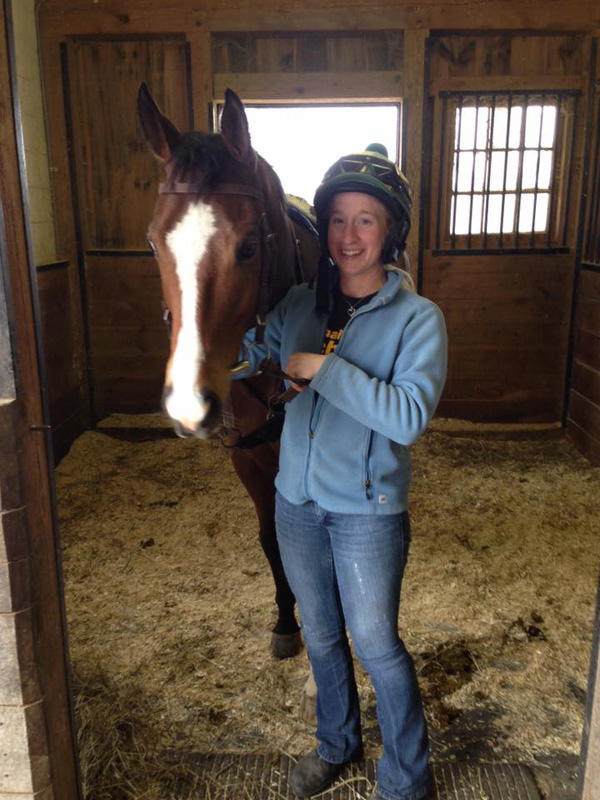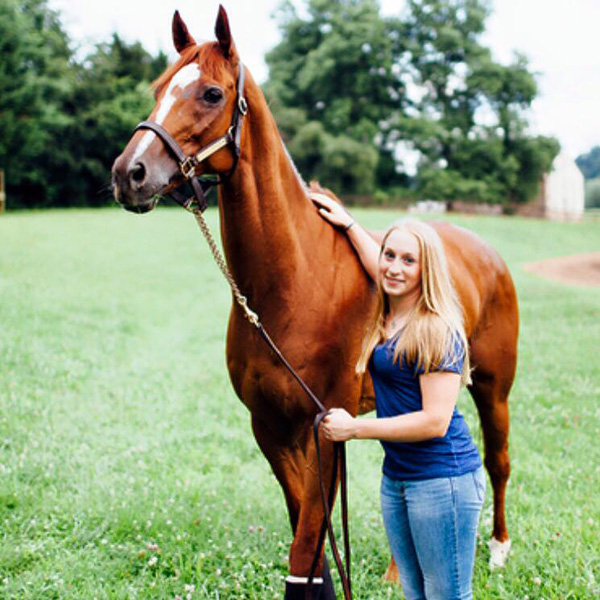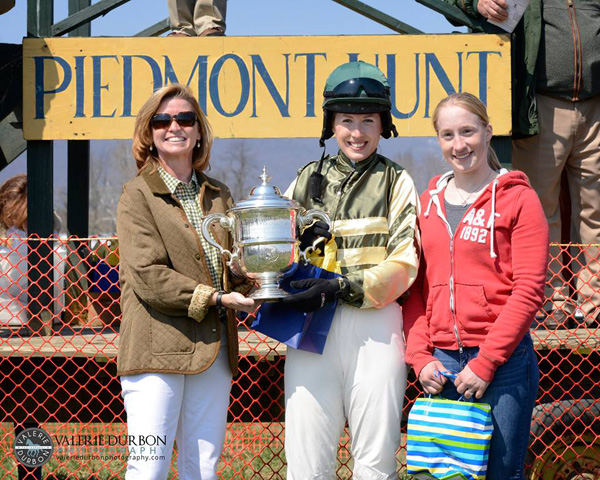





Keri Brion
Keri Brion is a young jockey that has rode in some flat races, but mostly has rode in steeplechase races and here is her story:
FOTH: Where were you born and where did you grow up? What sort of girl were you growing up?
KB: I was born in Lancaster, PA and grew up in Kirkwood, PA. Very small town, but happened to live right down the road from Ronnie and Betsy Houghton’s Sylmar Farm, which was my first job in the racehorse business. I was horse crazy from the time I was 4-5, but also very athletic and competed in many school sports along with the horses growing up.
FOTH: Now what did you want to be when you were growing up and what sort of dreams did you have as a young girl?
KB: I always wanted to do something with horses. I think I went from wanting to be a vet, to a jockey and/or trainer.
FOTH: Now were you into horse racing or horses in general at a young age or did that come later on? What did you think of horse racing the 1st time you saw a live horse race?
KB: As I said I grew up down the road from Ronnie and Betsy Houghton’s Sylmar Farm, and I started working there when I was 10 years old on the weekends. I was just scrubbing water buckets and cleaning halters when I started, but I fell in love with all the aspects that went into racehorses and running a racehorse operation. I was going to the races with the horses by the time I was 11, and wanted to learn everything I could about the industry. I knew from that time that it would be my future and I was not interested in anything else. When I started galloping at the age of 12 I actually got out of the lease I was in on an event horse.
FOTH: When did you know you wanted to be a jockey and what did your parents think when you told them you wanted to be one? Are they supportive of it?
KB: I started riding junior and pony races when I was 14. I rode a Thoroughbred named Ode to Joy who just happened to be 14.2 hands and qualified for pony races. We were undefeated for the 2 years I rode her. My “jockey” career started there, and although my parents thought I was crazy and I know were more interested in the sports I were involved in in school, they were very supportive and knew where my passion was.
FOTH: Take me through the steps of what you went through to be a jockey. How long did it take you from when you wanted to be one till you actually became one?
KB: Like I said, I started riding pony races when I was 14, and when I was 15 I started riding pony races along with Junior races at the steeplechase meets, which were races restricted to 15-18 year olds on horses. I rode them until I graduated high school, and I went away to college for one semester. When I came back, the spring of 2010, I rode my first official flat race at a steeplechase meeting, and I was hooked. At that time I started working for Jonathan Sheppard, and the first time I schooled a hurdle I knew I wanted to be a steeplechase jockey. It was another year until I rode my first hurdle race. It was also 2010 that I started riding Amateur Races at the real flat tracks.
FOTH: How long did it take you to exercise horses before you took your jockey license out? Did anyone teach you how to ride? Looking back was becoming a jockey harder or easier than you thought it was going to be?
KB: I started galloping when I was 10…at that time I had quite a few people helping me with my riding. Bernie and his wife Shannon Houghton both really helped me with me riding as I was learning how to hold horses and breeze horses. When I started working for Jonathan and was learning how to school horses over hurdles I also had a lot of people helping me out. Although I had a strong background in jumping, when you jump hurdles at a high speed you ride a lot differently than if you are jumping around a show ring. Brian Crowley played a big part in helping me with jump riding, along with my boss, Jonathan Sheppard.
FOTH: Now you started riding in 2010 and up until now you have rode in only 30 races. Why is that?
KB: I have ridden a lot of point to point races, which don’t show up on an equibase record. These races are “unsanctioned” but many have purse money and trainers use these races as a prep for sanctioned races. A lot of young riders get more opportunities to ride at point to point races and it is also a great chance to gain more experience. Steeplechase races only run from March to May, then July-September is Saratoga which is for the top riders ( I really hope to be there someday), and then against October- November. They only race on the weekends as well, and not every weekend- so there is much less opportunity and races in general in steeplechasing then flat racing.
FOTH: What track are you riding at these days? You also do not have a win so far. Is that very frustrating to you or are you of the mindset that your day will come?
KB: I actually had a win in an Amateur Race at DE Park last year, but the horse got a positive test and it got taken away from me- that was VERY frustrating. I have actually won a little under 20 races at point to points and in flat prep races at sanctioned meets that don’t show up on equibase. If you look me up on centralentryoffice.com It is a better way to see Jump Riders records �� However, riding my first winner under rules is something I am really anxious for. I had a few very nice horses I was slated to ride this year and they were plagued with injury, so it was a rough year for me. I am hoping 2016 will be my year!
FOTH: Do you feel you have had to work that much harder to earn the respect of trainers? What is a typical day like for you these days?
KB: It is VERY hard as an amateur jockey and a girl in the steeplechase world. Most trainers believe the guys are better and stronger. I am lucky because I work for a hall of fame trainer and he is behind me and puts me on nice horses, but it is very difficult to get rides for other people as they would rather have an experienced guy rather than someone really trying to get their career going. But as any girl or young rider in general I am persistent and hoping that success on my boss’ horses will help my chances of riding for other trainers as well. I am actually Jonathan Sheppards assistant trainer, so my day consists of running a 62 stall barn, along with exercising all the horses and most days working and schooling horses over hurdles. In the afternoons I will go to other trainers’ farms in the area to school their horses and try to get mounts.
FOTH: What has been the biggest surprise for you as far as being a rider and just being in the business in general?
KB: It is surprising to me how contradicting people are in the steeplechase business. Everyone complains that there are such a limited number of riders and not many people to choose from, however the same people that complain about this will not use young riders and are not interested in giving young riders opportunities and experience to help them grow into successful riders. If the business wants new and young riders, they need to take the steps and make the effort to put us on horses! That’s a big difference between flat racing and steeplechase racing…a bug boy/girl normally takes off in flat racing as everyone loves to have the weight off, whereas in steeplechasing the 10 lbs off still isn’t enough to sway a trainer to use you.
FOTH: What are some things you like to do when you’re not doing track related stuff?
KB: Well I am recently married to a mid atlantic jockey, Andrew Wolfsont, and we recently bought a house so right now I am doing a lot of house cleaning and decorating in my spare time. I also have 3 horses of my own that I enjoy riding for fun in my spare time. But being an assistant for Jonathan doesn’t allow me much spare time!
FOTH: Do you follow or like any other sports and stuff?
KB: Love Football! I am a die hard Philadelphia fan, and my family has season tickets to the Eagles games.
FOTH: Is weight a problem for you at all?
KB: Not really, I am pretty lucky. The only time I struggle is when I have to do bottom weight (130 is the lowest steeplechase racing weight can be). I like to ride in my heavier saddle over jumps, which weighs 5 lbs, so I have to be 124ish lbs and that is pushing it for me. I am normally right around 130, which is much lighter than most steeplechase jockeys.
FOTH: What are some of the things you see wrong in the sport of horse racing?
KB: There is plenty wrong for sure, but one thing that bothers me a lot is watching old war horses go down the ranks in claiming races and being run into the ground. I wish there was some kind of rule to prevent this. We wouldn’t have horse racing if it weren’t for the horses, and I wish the sport remembered that a little more at times. If a horse won a stake at one point in it’s life and/or has made over $500k, I don’t see why the horse needs to be running for $4,000 at Charles Town.
FOTH: Have you had any injuries be it as a jockey or during morning work-outs?
KB: Knock on wood; I haven’t had anything too serious. I fell head first when a horse went down with me around the turn on our wood chip track at Sheppard’s, I suffered a serious concussion and had the skin ripped off my face, which took awhile to heal, that was nasty. I suffered a sprained ankle in a fall over jumps in a race and my ankle swelled up to the point I had to cut my boot off, I couldn’t walk for almost week, but other than that- that’s all!
FOTH: Now you told me you rode in some steeplechase races. What places have you done this at and have you won any races as a steeplechase jockey?
KB: I have ridden at different steeplechase courses in PA, MD, DE, VA, and SC. I have won 18 total races between flat and jump races as a steeplechase jockey. At the steeplechase races they normally have one or two flat races on their race cards, and most younger jockeys get their start riding in those races before moving on to ride over jumps.
FOTH: Now for those who don't know, what is the difference between steeplechase races and regular horse racing races?
KB: Steeplechase Races are over jumps, and most times around courses that have many turns and are up and down hills. The jumps can be solid wood (that is timber racing) or have a plastic roll with plastic brush behind it (hurdle racing). Like I said earlier there are also flat races at the steeplechase races…all of these races including the flat races are started by lining up and waiting for a starter to drop a flag, there is no starting gate at the steeplechase races.
FOTH: Does the fear of getting hurt at all bother you at all?
KB: I have suffered a small fracture in my ankle have a fall in a hurdle race. I could not ride for a week and it swelled up to the point that I could not get my race boot off of my foot. Other than that, I have been pretty lucky. I do not worry about getting hurt, it is obviously in the back of my mind, but if you are scared of getting hurt I believe you ride scared, and then you are a danger to yourself and others on the course.
FOTH: Are there many other female steeplechase jockeys that you know of these days?
KB: There are not many female steeplechase jockeys. Danielle Hodsdon was a very prominent female steeplechase jockey in recent years, but has moved on to training. Annie Yeager and Bethany Baumgardner are two female steeplechase jockeys right now that ride a few races normally every weekend. But after us, there are not many others.
FOTH: If you were not a jockey what do you think you would be doing with yourself these days?
KB: I would definitely be doing something in the horse racing business. I would imagine training…I hope to move on to training after having a hopefully successful riding career, so if I wasn’t pursuing a jockey career I would probably have moved right into training!
FOTH: Keri good luck with the rest of your career and thumbs up for doing this interview, any last words to wrap it up?
KB: Thanks for the interview and I think that it’s great that you do this website! I think you should buy a few steeplechase horses and ride us female jockeys on them!!
Back to our main
page